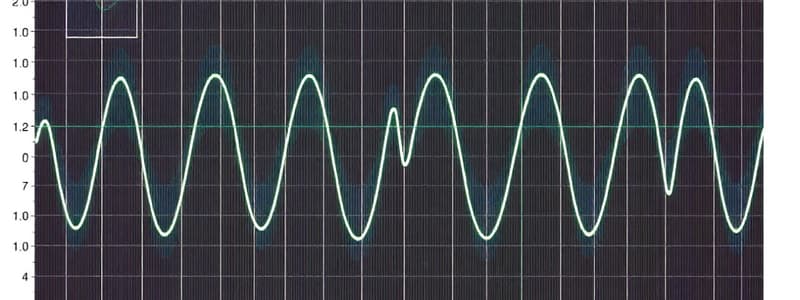Podcast
Questions and Answers
Which of the following electromagnetic waves has the LEAST wavelength range?
Which of the following electromagnetic waves has the LEAST wavelength range?
- Ultraviolet
- Infrared
- X-ray
- Visible light (correct)
Increasing the wavelength of an electromagnetic wave will cause its frequency to increase.
Increasing the wavelength of an electromagnetic wave will cause its frequency to increase.
False (B)
What is the color with the LONGEST wavelength in the visible spectrum?
What is the color with the LONGEST wavelength in the visible spectrum?
red
The electromagnetic wave that can travel the FARTHEST distances because it has a wavelength range greater than $1 \times 10^{-1}$ meters is a ______.
The electromagnetic wave that can travel the FARTHEST distances because it has a wavelength range greater than $1 \times 10^{-1}$ meters is a ______.
Which electromagnetic wave has the LOWEST frequency?
Which electromagnetic wave has the LOWEST frequency?
Match the following electromagnetic waves with their characteristics:
Match the following electromagnetic waves with their characteristics:
Which form of electromagnetic wave carries the MOST energy?
Which form of electromagnetic wave carries the MOST energy?
Gamma ray has the least energy compared to other electromagnetic waves.
Gamma ray has the least energy compared to other electromagnetic waves.
Which type of electromagnetic wave travels fastest in a vacuum?
Which type of electromagnetic wave travels fastest in a vacuum?
Electromagnetic waves require a medium to travel through.
Electromagnetic waves require a medium to travel through.
What phenomenon causes electromagnetic waves to be generated?
What phenomenon causes electromagnetic waves to be generated?
The electromagnetic spectrum includes radio waves, microwaves, infrared, visible light, ultraviolet, X-ray, and _______.
The electromagnetic spectrum includes radio waves, microwaves, infrared, visible light, ultraviolet, X-ray, and _______.
Which electromagnetic wave has the shortest wavelength?
Which electromagnetic wave has the shortest wavelength?
Electromagnetic waves can carry energy as they propagate.
Electromagnetic waves can carry energy as they propagate.
What is the wavelength range of visible light?
What is the wavelength range of visible light?
Which type of electromagnetic wave has a range of $7 \times 10^{-7} m$ to $1 \times 10^{-3} m$?
Which type of electromagnetic wave has a range of $7 \times 10^{-7} m$ to $1 \times 10^{-3} m$?
Ultraviolet waves have a longer wavelength range than x-rays.
Ultraviolet waves have a longer wavelength range than x-rays.
What electromagnetic wave can travel the farthest distances due to its wavelength being greater than $1 \times 10^{-1} m$?
What electromagnetic wave can travel the farthest distances due to its wavelength being greater than $1 \times 10^{-1} m$?
The wavelength of microwaves ranges from $1 \times 10^{-1} m$ to $1 \times 10^{-3} m$, which is comparable in size to a ______.
The wavelength of microwaves ranges from $1 \times 10^{-1} m$ to $1 \times 10^{-3} m$, which is comparable in size to a ______.
Which electromagnetic wave has the least wavelength range?
Which electromagnetic wave has the least wavelength range?
Identify the electromagnetic wave with the highest frequency.
Identify the electromagnetic wave with the highest frequency.
The energy of an electromagnetic wave is inversely proportional to its frequency.
The energy of an electromagnetic wave is inversely proportional to its frequency.
What is the constant speed of electromagnetic waves in a vacuum?
What is the constant speed of electromagnetic waves in a vacuum?
Gamma rays have the longest wavelength among all electromagnetic waves.
Gamma rays have the longest wavelength among all electromagnetic waves.
What type of electromagnetic wave can be seen by the naked eye?
What type of electromagnetic wave can be seen by the naked eye?
Electromagnetic waves are produced by changing an ______ and a ______.
Electromagnetic waves are produced by changing an ______ and a ______.
Red light has the greatest frequency in the visible spectrum.
Red light has the greatest frequency in the visible spectrum.
Which electromagnetic wave is associated with cooking food?
Which electromagnetic wave is associated with cooking food?
Which of the following options is arranged from lowest to highest energy?
Which of the following options is arranged from lowest to highest energy?
Ultraviolet rays have higher energy than visible light.
Ultraviolet rays have higher energy than visible light.
Name the type of electromagnetic wave known for being invisible but causing sunburn.
Name the type of electromagnetic wave known for being invisible but causing sunburn.
The __________ is the part of the electromagnetic spectrum that is visible to the human eye.
The __________ is the part of the electromagnetic spectrum that is visible to the human eye.
Match the following electromagnetic waves with their details:
Match the following electromagnetic waves with their details:
What is the speed of an electromagnetic wave in a vacuum?
What is the speed of an electromagnetic wave in a vacuum?
Microwaves have a longer wavelength than visible light.
Microwaves have a longer wavelength than visible light.
What type of electromagnetic wave has a wavelength similar to the size of a 1 Peso coin?
What type of electromagnetic wave has a wavelength similar to the size of a 1 Peso coin?
The ______ has the highest energy among electromagnetic waves.
The ______ has the highest energy among electromagnetic waves.
Which property distinguishes radio waves from microwaves?
Which property distinguishes radio waves from microwaves?
Match each electromagnetic wave to their corresponding frequency range:
Match each electromagnetic wave to their corresponding frequency range:
Which color of light corresponds to a frequency of 4.5 x 10^14 Hz?
Which color of light corresponds to a frequency of 4.5 x 10^14 Hz?
As the wavelength of a wave increases, its energy also increases.
As the wavelength of a wave increases, its energy also increases.
Flashcards
Visible Light Wavelength
Visible Light Wavelength
Visible light is a range of electromagnetic waves that can be seen by the human eye.
Shortest Electromagnetic Wavelength
Shortest Electromagnetic Wavelength
X-rays have the shortest wavelength in the given options.
Electromagnetic Wave Frequency Change
Electromagnetic Wave Frequency Change
If the wavelength of an electromagnetic wave increases, its frequency decreases.
Longest Wavelength Electromagnetic Wave
Longest Wavelength Electromagnetic Wave
Signup and view all the flashcards
Infrared vs. Ultraviolet
Infrared vs. Ultraviolet
Signup and view all the flashcards
Electromagnetic Wave Distance
Electromagnetic Wave Distance
Signup and view all the flashcards
Lowest Electromagnetic Frequency
Lowest Electromagnetic Frequency
Signup and view all the flashcards
Shortest Electromagnetic Wavelength (Specific)
Shortest Electromagnetic Wavelength (Specific)
Signup and view all the flashcards
What are Electromagnetic Waves?
What are Electromagnetic Waves?
Signup and view all the flashcards
What is the Electromagnetic Spectrum?
What is the Electromagnetic Spectrum?
Signup and view all the flashcards
Which EM wave has the longest wavelength?
Which EM wave has the longest wavelength?
Signup and view all the flashcards
Which EM wave has the shortest wavelength?
Which EM wave has the shortest wavelength?
Signup and view all the flashcards
Wavelength and Frequency Relationship
Wavelength and Frequency Relationship
Signup and view all the flashcards
What is the relationship between red and violet light in the visible spectrum?
What is the relationship between red and violet light in the visible spectrum?
Signup and view all the flashcards
What is the difference between Infrared and Ultraviolet?
What is the difference between Infrared and Ultraviolet?
Signup and view all the flashcards
How do EM waves travel?
How do EM waves travel?
Signup and view all the flashcards
Electromagnetic Spectrum
Electromagnetic Spectrum
Signup and view all the flashcards
Wavelength & Energy
Wavelength & Energy
Signup and view all the flashcards
Which EM wave has the highest energy?
Which EM wave has the highest energy?
Signup and view all the flashcards
Which EM wave has the lowest frequency?
Which EM wave has the lowest frequency?
Signup and view all the flashcards
Frequency & Energy
Frequency & Energy
Signup and view all the flashcards
Electromagnetic Wave
Electromagnetic Wave
Signup and view all the flashcards
Speed of Light
Speed of Light
Signup and view all the flashcards
Wavelength and Frequency
Wavelength and Frequency
Signup and view all the flashcards
Energy and Frequency
Energy and Frequency
Signup and view all the flashcards
Visible Light
Visible Light
Signup and view all the flashcards
Gamma Rays
Gamma Rays
Signup and view all the flashcards
Radio Waves
Radio Waves
Signup and view all the flashcards
Electromagnetic Wave Speed
Electromagnetic Wave Speed
Signup and view all the flashcards
Radio vs. Microwave Difference
Radio vs. Microwave Difference
Signup and view all the flashcards
Ultraviolet Frequency Range
Ultraviolet Frequency Range
Signup and view all the flashcards
Visible Light Color and Frequency
Visible Light Color and Frequency
Signup and view all the flashcards
Electromagnetic Wavelength Order
Electromagnetic Wavelength Order
Signup and view all the flashcards
Wavelength and Energy Relationship
Wavelength and Energy Relationship
Signup and view all the flashcards
Shortest Wavelength in Visible Spectrum
Shortest Wavelength in Visible Spectrum
Signup and view all the flashcards
Most Energetic Electromagnetic Wave
Most Energetic Electromagnetic Wave
Signup and view all the flashcards
Energy & Wavelength
Energy & Wavelength
Signup and view all the flashcards
Order of EM Waves by Energy
Order of EM Waves by Energy
Signup and view all the flashcards
Study Notes
Science Module 1: Different Forms of EM Waves
- This module focuses on electromagnetic waves
- Students will learn about the different forms of EM waves, their characteristics, and relationships.
- The module includes activities to assess understanding of EM waves.
- It covers comparing wavelengths, frequencies, and energy relations of different EM waves.
- There are pre-tests and post-tests to evaluate prior knowledge and learning, respectively.
- The module is designed for self-paced learning and independent study.
- Students are expected to compare the relative wavelengths and frequencies of different electromagnetic waves and identify relationships among wavelength, frequency, and energy.
- The material includes an electromagnetic spectrum, which details the different types of EM waves arranged by frequency and wavelength.
- The module provides notes for teachers and parents on supporting home-based learning.
- The activities involve student observation and drawing of waves.
- Students will need to understand prior knowledge of wave properties, such as crest, trough, amplitude, and frequency.
- The module includes illustrations, diagrams, and tables clarifying the information.
- The module's information is aligned to Grade 10 standards and the learning competencies outlined in S10FE-IIa-b-47.
Studying That Suits You
Use AI to generate personalized quizzes and flashcards to suit your learning preferences.




